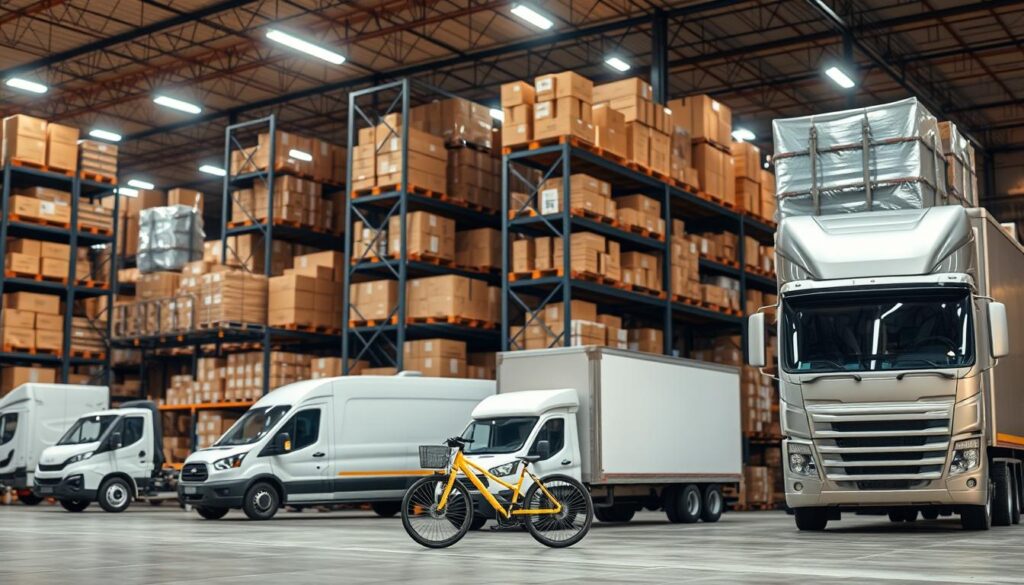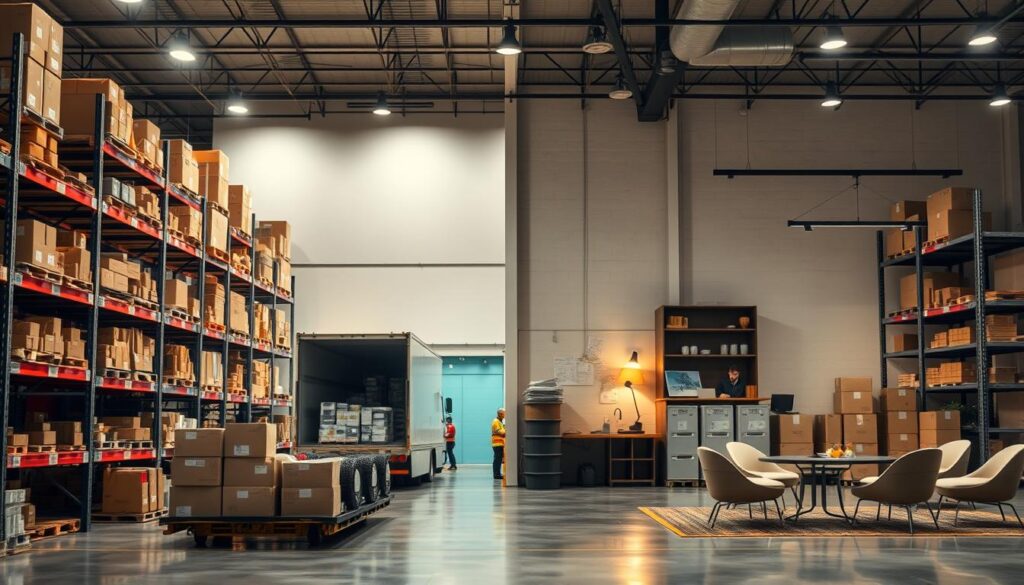Ever wondered what happens after you order something online? The process is more than just sending a package. It involves many steps to get your item to you on time.
Knowing the difference between shipping and delivery is key for a good online shopping experience. These terms mean different things in your package’s journey.
In this article, we’ll dive into the details of shipping and delivery. This will help you make better choices when shopping online.
Key Takeaways
- Shipping is about moving goods from the seller to the buyer.
- Delivery is when the package is given to the customer.
- Understanding the difference can make your online shopping better.
- Logistics are important in both shipping and delivery.
- Knowing what to expect helps track your packages better.
Understanding the Terminology
When you shop online, knowing the difference between shipping and delivery is key. Getting your items from the seller to you involves several steps. Understanding these terms helps clarify what happens at each stage.
What Is Shipping?
Shipping means moving goods from one place to another. It starts with dispatching an item from a warehouse or seller’s location to you. Shipping uses different methods like ground, air, and sea transport. It’s a big part of online shopping.
The shipping process includes getting ready, packing, and moving the goods.
What Is Delivery?
Delivery is the last step to get the package to you. It’s when the package is handed over to the customer. Delivery can happen through postal services, courier companies, or in-person.
The main goal of delivery is to make sure the package gets to you safely and on time.
Shipping vs Delivery: The Fundamental Differences
Shipping and delivery are two key parts of the supply chain. Shipping is about moving goods from the seller to the buyer. Delivery is when the product is finally given to the customer.
Learn more in this detailed guide comparing shipping and delivery.
Process Comparison
Shipping includes steps like packaging and labeling. Goods are then moved by ground, air, or sea. Delivery is the last step, where the product reaches the customer. The shipping methods vs delivery methods have big differences in logistics and cost.
Responsibility Boundaries
Shipping’s responsibility falls on the seller or carrier until the product reaches the delivery service. Then, the delivery service takes over. Knowing these boundaries helps solve shipping vs delivery time issues.
Legal Distinctions
Shipping and delivery have legal differences, especially in liability and insurance. Shipping services have their own insurance and liability rules. Businesses and consumers need to understand these when picking shipping services.
| Aspect | Shipping | Delivery |
|---|---|---|
| Process | Transporting goods from seller to buyer | Final handover to the customer |
| Responsibility | Seller or shipping carrier | Delivery service provider |
| Legal Liability | Varies by shipping service | Varies by delivery service |
The Complete Shipping Process Explained
To understand shipping well, knowing the shipping process is key. It covers preparation, packaging, transportation, and delivery. Each step is important to ensure goods arrive safely and on time.
Preparation and Packaging
The first step is getting items ready and packaged. This means wrapping and securing items to avoid damage. Good packaging protects goods and helps in handling them right.
A logistics expert says, “Effective packaging is key to avoid damage. It ensures products arrive safely.”
Transportation Methods
Transportation is a big part of shipping. There are air, land, and sea options. The choice depends on the goods, how fast they need to arrive, and the cost.
Air transport is quick but pricey. Sea freight is cheaper for big shipments but takes longer.
To learn more about the benefits of shipping by sea, see our post on Advantages of maritime transport for your shipments.
Customs and International Considerations
For international shipments, clearing customs is crucial. This means following rules, paying duties, and having the right documents. Knowing customs helps avoid delays and extra costs.
Key Players in the Shipping Industry
The shipping world has many players like carriers, freight forwarders, and logistics providers. Each is important for moving goods smoothly. As the shipping world changes, knowing these roles helps businesses make better choices.
The Delivery Process Breakdown
Delivery is more than just bringing a package to your door. It’s about giving you a smooth experience. When you shop online, knowing how delivery works helps you see the effort put into getting your items to you fast.
Last-Mile Delivery Explained
Last-mile delivery is the final step, where your package goes from a local hub to your door. It’s the toughest part because it needs exact timing and navigating through busy cities. Efficient last-mile delivery is key to making customers happy.
Delivery Service Providers
Companies like UPS, FedEx, and USPS are crucial in the delivery process. They offer services like fast shipping and tracking to fit your needs. When picking a service, think about cost, reliability, and how fast they deliver.
Delivery Confirmation Processes
Delivery confirmation checks if a package is delivered to the right person. This can be done with signature upon delivery or through tracking technology. Good delivery confirmation stops problems and makes customers feel secure.
![]()
Understanding the delivery process shows you the hard work behind getting your packages. From last-mile delivery to choosing the right service, each step is important for a great customer experience.
Comparing Costs: Shipping vs Delivery Expenses
When you send packages, knowing the difference between shipping and delivery costs is key. This knowledge helps you save money and make smart choices.
Factors Affecting Shipping Costs
Several things affect shipping costs. The package’s weight, size, shipping speed, and distance all play a role. For example, fast shipping like overnight or 2-day delivery is pricier than slower options.
The type of item being shipped also matters. Items that need special care, like perishables or hazardous materials, cost more. Fuel prices and carrier fees can also raise the total cost.
Understanding Delivery Fee Structures
Delivery fees depend on the service provider and the service level. Same-day delivery, for instance, is more expensive than regular delivery.
Some services charge extra for things like signature upon delivery or for reaching remote areas. Knowing these fees helps you pick the best option for your budget.
Hidden Fees to Watch For
Both shipping and delivery can have hidden costs. These might include fees for home delivery, fuel surcharges, or extra handling fees.
| Fee Type | Description | Potential Cost |
|---|---|---|
| Residential Delivery Fee | Fee for delivering to residential areas | $5-$10 |
| Fuel Surcharge | Additional fee due to fuel price fluctuations | 3%-5% of total cost |
| Handling Fee | Fee for packages requiring special handling | $10-$20 |
Knowing about these extra fees helps you plan better. It lets you make choices that fit your budget.
Choosing the Right Method for Your Needs
It’s important to know the difference between shipping and delivery. This knowledge helps you make choices that fit your needs. Whether you’re running a business or just need something delivered, picking the right option matters a lot.
Common Shipping Methods
There are many shipping methods out there. You can choose from ground transportation, air freight, and express courier services. Ground transport is usually cheaper for items that don’t need to arrive quickly. But, if you need something fast or it’s very valuable, air freight is the way to go.

Popular Delivery Options
Delivery options have changed a lot to meet what customers want. You can pick from same-day delivery, next-day delivery, and standard delivery. In cities, people often want their items quickly, so same-day and next-day delivery are big hits.
Decision Factors for Businesses
Businesses have to think about a few things when picking between shipping and delivery. They need to look at cost, how reliable it is, and what customers expect. By comparing these, businesses can make smart choices.
| Factor | Shipping | Delivery |
|---|---|---|
| Cost | Generally lower | Can be higher, especially for express options |
| Reliability | Depends on the carrier | Often more reliable due to direct handling |
| Customer Expectations | Vary by industry | High for direct-to-consumer deliveries |
Decision Factors for Consumers
When you’re choosing between shipping and delivery, think about how fast you want it, the cost, and if you can track it. Knowing these things helps you pick what’s best for you.
By looking at these factors and understanding the differences between shipping and delivery, both businesses and consumers can make better choices. This improves their overall experience.
Package Tracking Systems Compared
Understanding package tracking systems is key in today’s shipping world. It lets you know where your packages are at all times. This is crucial for keeping up with your shipments.
How to Track Shipping Status
To track your shipment, you need a tracking number from the carrier. You can put this number into the carrier’s website or use a tracking app. Most carriers also send updates by email or SMS.
Understanding Delivery Tracking Information
Delivery tracking info tells you where your package is and when it will arrive. It shows the package’s location, estimated delivery date, and any delivery attempts. This info helps you plan for when you’ll get your package.
Using Tracking Apps and Tools
There are many tracking apps and tools to help you monitor your shipments. These apps let you track packages from different carriers in one place. They also send notifications and give estimated delivery times. Using these tools makes tracking your shipments easier and more convenient.
International vs Domestic: Key Differences
It’s important to know the difference between international and domestic shipping. This knowledge helps businesses and customers. It affects the cost, how long it takes to get items, and how happy customers are.
International Shipping Considerations
International shipping means crossing borders. This makes things more complicated because of customs rules, duties, and taxes. You need to have the right documentation, like commercial invoices and certificates of origin, for customs to clear your shipment.
Also, international shipping takes longer and costs more. This is because of the distance and the need for different ways to transport goods.
Domestic Delivery Advantages
Domestic delivery is faster and simpler. It happens within the same country, so you don’t face international customs or long-distance transport. This means faster delivery times and often lower costs.
Domestic delivery is great for businesses that need to restock quickly. It’s also good for customers who want their items fast.
Navigating Customs and Regulations
Understanding customs and regulations is key for international shipping. You need to know the customs regulations of both the country you’re shipping from and the one you’re shipping to. This includes knowing what items are restricted or prohibited and following all laws.
Properly classifying your goods and providing accurate documentation can prevent delays and extra costs.
Troubleshooting Common Problems
Knowing how to fix common shipping and delivery problems can save a lot of time and stress. Whether you’re a business or a consumer, learning how to troubleshoot can greatly improve your experience.
Shipping Delays and How to Handle Them
Shipping delays can be really frustrating. But, there are steps you can take to lessen their impact. First, check the shipping status often to stay informed about any changes. If a delay happens, reach out to the shipping carrier to find out why and when it will be fixed. You might also want to expedite shipping or try a different carrier if delays keep happening.
- Identify the cause of the delay
- Communicate with the shipping carrier
- Explore alternative shipping options
Delivery Issues and Resolution Strategies
Delivery problems, like missed deliveries or wrong addresses, need quick action. Verify the delivery address before you ship to avoid mistakes. If a problem comes up, get in touch with the delivery service to fix it. Keeping a record of delivery attempts and talks can be very helpful.
- Confirm the delivery details
- Contact the delivery service
- Document all interactions
Filing Claims for Lost or Damaged Items
If your item gets lost or damaged, filing a claim is key. Gather all necessary documentation, like receipts and proof of damage, to back up your claim. Then, reach out to the shipping or delivery carrier’s customer service to start the claims process.
Preventative Measures for Smoother Experiences
To avoid shipping and delivery problems, think about implementing preventative measures. These include using proper packaging, accurate labeling, and picking reliable carriers. By doing these things, you can greatly lower the chance of issues.
Conclusion
You now know the main differences between shipping and delivery. Shipping moves goods over long distances, often using many carriers. Delivery is the last step, where the package is given to the customer.
It’s key for businesses and customers to understand these differences. This knowledge helps manage expectations, cut costs, and boost satisfaction. Whether you’re a business or a shopper, knowing these differences matters a lot.
The e-commerce world is getting bigger, making it more important to know about shipping vs. delivery. By understanding the processes, costs, and who’s responsible, you can make better choices. This helps your business or makes shopping better for you.

